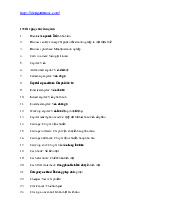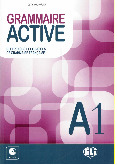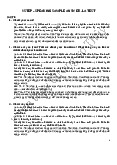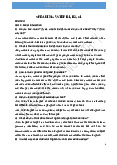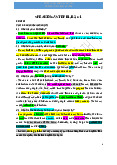


Preview text:
New Study Shows an Alarming Decline in Insect Populations Sun Feb 10 2019
Have you noticed that fewer bugs are hitting your windshield (kính chắn gió xe hơi / w ˈ nd. ɪ i
ʃ ːld/) nowadays? Or perhaps that the fireflies (con đom đóm / ˈfa ə.fla ɪ
ɪ/) of your childhood are disappearing? A new study published in the
journal Biological Conservation reports that 40 percent of insect species are in
decline and may die out within the next century. The current rate of extinction for
insects is an alarming (đáng báo động /əˈl .m ɑː
ɪŋ/) eight times higher than that
of mammals (động vật có vú / mæm. ˈ
əl/), birds, and reptiles (loài bò sát / ˈrep.ta l/)
ɪ . This adds to the body of research that shows that Earth is now
experiencing the sixth mass extinction in its history. Losses of larger animals that
are easier to study have already been reported and are being studied, but there is
not as much data about insects and smaller creatures. However a growing number
of studies have begun to piece together the breadth (bề rộng /bredθ/) and scope (phạm vi /skə p/) ʊ of insect losses.
In 2014, an international team of biologists estimated that invertebrate (loài
không xương sống /ɪnˈvɜː.tɪ.brət/) abundance had fallen by 45 percent
worldwide. In an unsettling (đáng lo ngại) report from 2017, European
researchers found that the insect abundance had dropped more than 75 percent in
certain nature preserves in Germany in the previous few decades. Last year,
researchers from the U.S. and Mexico published their findings that the biomass of
insects and other arthropods (động vật chân đốt / .θrə.p ˈɑː d/ ɒ ) (spiders,
centipedes (con rết / sen.t ˈ .pi ɪ d/) ː
, etc.) in a rainforest in Puerto Rico had
decreased by 10 to 60-fold (lần) since the 1970s. They additionally found that
populations of animals that eat insects such as lizards, birds, and frogs showed a
similar decline; the number of birds collected for the study in the area fell by 50 percent between 1990 and 2005. Causes
The causes of these losses are many, and vary from region to region. In areas with
industrialized agriculture, intensive (nhiều) use of herbicides (thuốc diệt cỏ / ˈhɜː.b .sa ɪ
ɪd/), pesticides (thuốc trừ sâu / pes.t ˈ .
ɪ saɪd/), and fungicides (thuốc diệt nấm / f ˈ ŋ. ʌ .
ɡɪ saɪd/) is harming insect populations. Neonicotinoids, a new
type of pesticide in use for the past 20 years, have been found to be particularly
harmful. In the tropics, where intensive agriculture (nền nông nghiệp thâm
canh) is not prevalent (phổ biến / prev ˈ
.əl.ənt/), one main factor is climate
change. In the area of Puerto Rico where the 2018 study was done, the average
high temperature had increased by four degrees Fahrenheit over the 40-year period
of the study. Other factors include habitat loss and habitat degradation (sự xuống
cấp, sự thoái hóa /ˌdeɡ.rəˈdeɪ.ʃən/) due to deforestation, large-scale (quy mô lớn /ˌl d ɑː ske ʒˈ l
ɪ /) agriculture, urbanization (sự đô thị hóa /ˌɜː.bən.a ze ɪˈ . ɪ ʃən/), and
air, water, and light pollution. Globalization also plays a role, by
spreading invasive (xâm lược, xâm chiếm) species,
parasites (động, thực vật ký
sinh /ˈpær.ə.saɪt/), and pathogens (mầm bệnh / pæθ.ə.d ˈ
ʒən/) that are harmful to
insects to the most remote regions of the planet in record time.
Repercussions (ảnh hưởng, hậu quả /ˌriː.pə k ˈ . ʌʃ ən/)
Of all insects, some of the most threatened species are butterflies and moths
( bướm đêm /mɒθ/), pollinators (loài thụ phấn / p
ˈ ɒl.ə.neɪ.tər/) such as bees,
and dung beetles (bọ phân /d ŋbi ʌ .t
ː əl/). Although many people find insects to
be pesky (làm khó chịu / pes. ˈ
ki/) creatures with their bites and stings, their
damage to crops, and the diseases they sometimes carry, the loss of these and other
insects would be detrimental (có hại, bất lợi /ˌdet.r men.t ɪˈ
əl/) to the earth and to
humankind, as insect populations dying out can lead to ecosystem collapse (sự suy
giảm, sự sụp đổ /kəˈlæps/). Insects are ecosystem linchpins (trụ cột / lˈ nt ɪ .p ʃ ɪn/);
as the base of the food web they are sustenance (thức ăn / s ˈ s.t
ʌ ən.əns/) for birds,
small mammals, and fish, and their loss can have a domino effect on the animals in
an ecosystem, causing subsequent groups of animal species to starve to death. In
addition, around three-fourths of all flowering plants on the planet rely on insects
for pollination, as do 35 percent of cultivated crops. As for dung beetles, they may
not be as cute as bees and butterflies, but they provide an essential function in
helping the decomposition (sự phân hủy / di ˌ .k
ː ɒm.pəˈzɪʃ.ən/) of feces (phân /
ˈfiː.siːz/) and detritus (vật vụn, mảnh vụn /d tra ɪˈ .tə ɪ s/) (breaking down and
removing plant and animal waste), and the effects of their loss would be extremely
unpleasant, to say the least. Needless to say, a change in mentality about insects
is vital, and further studies in other areas of the world must be done in order to begin to tackle this problem.
(Nguồn ENews, New Study Shows an Alarming Decline in Insect Populations)
